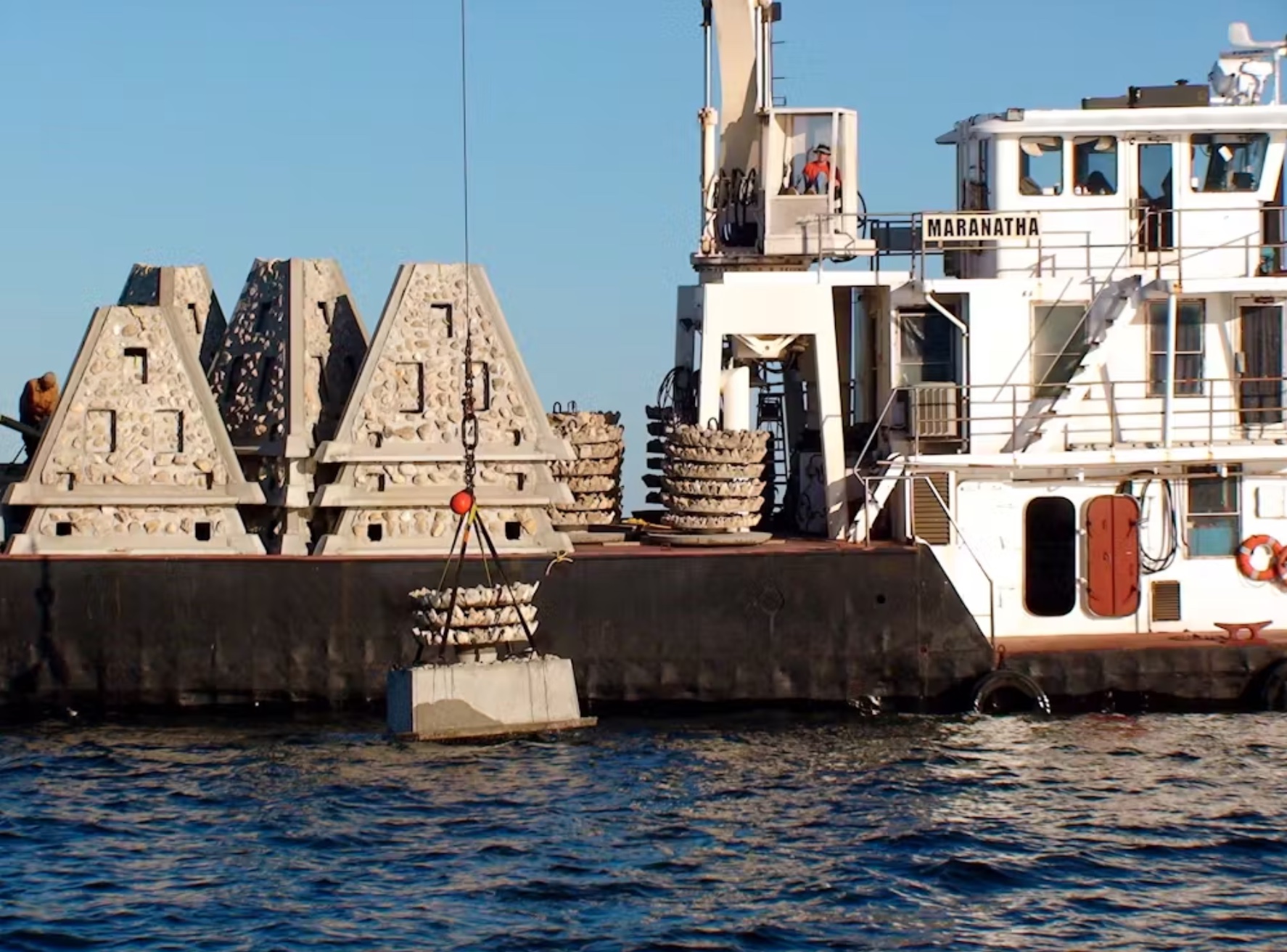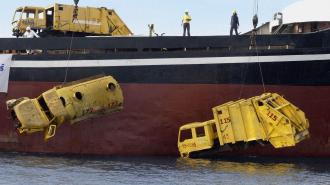When people hear about underwater reefs, they usually picture colorful gardens created from coral. But some reefs are anchored to much more unusual foundations.
For more than a century, people have placed a wide assortment of objects on the seafloor off the U.S. coast to provide habitat for marine life and recreational opportunities for fishing and diving. Artificial reefs have been created from decommissioned ships, chicken transport cages, concrete pipes, rail cars and more.
We study how ocean-dwelling fish use artificial reefs in the U.S. and beyond. Through our research, we have learned that artificial reefs can be hot spots for large predatory fish such as groupers and jacks. They also can serve as stepping stones for reef fish expanding their range northward with warming water temperatures and as rest stops for sharks.
Artificial reefs can be strategically designed and placed to optimize fish habitat. But although they provide valuable ecological services, no one has inventoried how many of these structures exist in U.S. waters or how much seafloor they occupy.
To help fill this knowledge gap, we led a team of scientists and artificial reef directors from the 17 U.S. states with artificial reef-building programs in the first national calculation of artificial reef extent. Our new study shows that these reefs cover a total of about 7 square miles (19 square kilometers) of U.S. seafloor – an area equivalent to 3,600 football fields. We also describe the diversity of objects used to create reefs, as well as patterns in artificial reef creation over time.
Creating modern artificial reefs
Modern reefing is different from dumping trash into the water and is regulated at the federal and state levels. A rigorous permitting and approval process ensures that the proposed objects or materials are appropriate to deploy in the ocean.
For example, decommissioned ships are thoroughly cleaned and drained of fuel and other polluting substances prior to sinking to minimize environmental risks. Some materials that were once used to create artificial reefs, such as rubber, fiberglass, wood and plastic, are now prohibited because they may move from their placed location, damaging nearby habitat, or deteriorate quickly in salt water.
Reefed objects can be sunk only in predesignated areas of the U.S. seafloor. These zones, which are usually sandy sea bottom, total about 2,200 square miles (5,800 square kilometers) – roughly the area of Delaware.
Each zone can support the creation of many individual reefs over multiple decades. Within a given zone, reefed objects are usually placed away from one another, separated by large swaths of sand. This maximizes the amount of sand habitat, where some reef fish forage.
The extent of artificial reefs in these zones has increased by about 2,000% over the past 50 years. Since 2010, however, artificial reef extent has grown only 12%. This is likely because of challenges in acquiring and sinking acceptable reef materials. It could also reflect a push toward developing structures specifically for use as artificial reefs.
Planes, trains and automobiles
For our study, we gathered records of intentional reefings dating back to 1899 and occurring off artificial all U.S. coastal states, except for six without artificial ocean reef programs: Maine, New Hampshire, Connecticut, Oregon, Washington and Alaska.
For some of these events, especially in recent decades, there were detailed records of the sizes and quantities of sunken objects or seafloor maps from which we could derive these measurements. These reefs were easy to quantify.
Other records, including some from the early 20th century, had scant detail. For these, we developed an approach to estimate how much seafloor the reefs covered, based on similar deployments with better records.
Our study found a vast assortment of reefed objects on the U.S. seafloor. They included decommissioned tugboats, fishing vessels, barges, ferries and military vessels. Reefs have also been created from rail boxcars, aircraft, vehicles, chicken transport cages, voting machines, missile platforms, concrete pipes, radio towers, tires, limestone rocks and objects purposely designed as artificial reefs.

Objects that occupy the largest amount of seafloor include limestone rocks, large concrete modules designed specifically for reefing, metal rigs and towers and long, narrow concrete pieces repurposed from their previous uses, such as culverts or bridges.
Potential impacts
After a reef is created, fish can appear within minutes or hours. The sequence of fish arrival sometimes follows a pattern. Transient fish such as jacks and barracuda come first, followed by bottom-dwelling fish such as grouper and smaller reef fish. With time, plants and animals grow on the hard surfaces of the artificial reef, helping to provide food and sanctuary for fish.
However, these reefs can also cause ecological harm. Invasive species, such as plants and other animals that grow on hard structures, can use artificial reefs to spread to new places.
Artificial reefs also may attract fish away from nearby natural reefs. Since constructed reefs are often in prime recreational fishing locations, this could lead to higher catches of those species.
Another risk is that if artificial reefs are improperly placed or secured on the sea floor, they can shift into unintended areas and harm sensitive habitats, particularly in the aftermath of storms. For example, Florida sank 1 million to 2 million tires offshore in the 1970s in an effort to create artificial reefs, but sea life didn’t colonize them as intended. Now the tires are washing around and smothering coral.
Learning from artificial reefs
Monitoring how fish and other species use artificial reefs, especially compared with naturally occurring reefs, will be key for understanding benefits and risks from these structures. As climate change continues to alter ocean ecosystems, we see opportunities to learn which types of artificial reefs are best suited for enhancing habitat for particular sorts of fish.
For example, we know that large predators that dwell in open water, such as jacks, barracuda and sharks, tend to prefer taller artificial reefs over shorter ones. This is similar to insights from oil rigs, showing that these vertical and complex structures are valuable fish habitat. More than 500 decommissioned oil rigs have been converted to reefs. Our calculation included only those that are managed by state artificial reef programs.
Other structures in the water, such as offshore wind turbine foundations, will likely form habitat for sea life similarly to artificial reefs. Insights about what types of structures different fish prefer may help guide the design or location of offshore wind farms.
Humans rely on the ocean for many benefits, including food, commerce, energy and a stable climate. Measuring artificial reefs’ footprint is a first step toward understanding their effects, both good and bad, on ocean wildlife and human uses of the ocean.
Brendan Runde, a marine scientist at The Nature Conservancy, contributed to this article.
This article is republished from The Conversation under a Creative Commons license. Read the original article.






